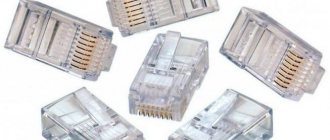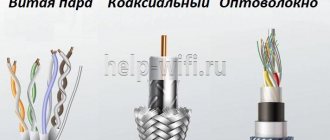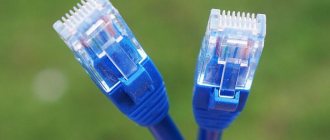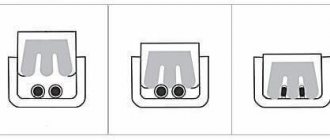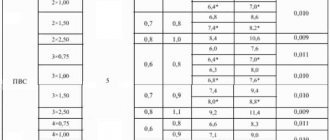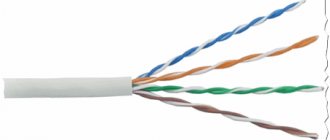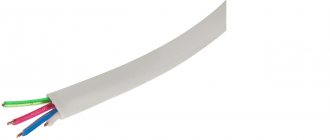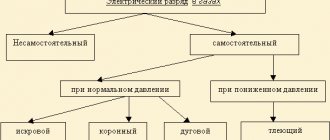Author of the article
Anton Bogdanov
Communication Network Design Engineer
Despite the fact that optical cable communication lines are gradually becoming more accessible, more devices are appearing that support working with them, and in general, working with this material is becoming easier, twisted pair cables, as before, remain the most affordable and convenient way to connect to the Internet .
Definition and device
So what is twisted pair and why is it actually twisted? The fact is that this cable consists of pairs of conductors twisted together. The choice of conductor material, number of turns, insulation and the presence of a screen determine the throughput, range and operating conditions of the cord. Internet cable is used to connect devices and transmit information using Ethernet technology.
The main difference from other cables is that one conductor wraps around the other, which is why the cable has this name. The signal is applied to both conductors of the pair at once, but along one of them it travels in antiphase. When receiving a signal through a pair of wires, the useful signal is summed (because it goes in antiphase), and the interference is subtracted (they go in the same phase). This way you can get rid of a lot of signal interference. Additionally, the cores are twisted together to reduce interference.
Methods for determining the quality of a twisted pair cable
To determine which twisted pair cable is best for the Internet, experts advise paying attention to the brand name. Among European manufacturers, it is worth noting Reichle De-Massari (Switzerland), Mollex (USA) has a good cable. The remaining brands found in Russia are mainly from China (or Taiwan), although the labeling may be different if the customer so desires.
The second criterion we pay attention to is the material used to make the cores. Copper is the standard for twisted pair, but recently you can often find bimetallic conductors, which are inferior in quality to copper ones. They are steel (CCS) or aluminum (CCA) wire clad with a thin layer of copper.
Cable composition: twisted pair
Such products are more affordable, but have a number of disadvantages that are not typical for pure copper cores:
- such conductors are not fixed securely enough in the connectors, forming a so-called “floating” contact;
- there is a limitation on the length of bimetallic twisted pair sections (up to 25 meters at 100 meters for a classic copper cable);
- When a twisted pair is inserted into a connector, significant fluctuations in wave impedance are possible, which affects the stability of signal transmission to the end device;
- in case of damage or the need to re-lay the cable, one cannot count on maintaining the previous characteristics;
- for cables with a steel core, the maximum information transfer speed will be within 10 Mb/s, for conductors with an aluminum core – up to 100 Mb/s.
It’s quite simple to make sure that you have a copper-plated vein in front of you. It is enough to try to scrape off the top layer with a knife. If silvery metal appears under the copper, you can rest assured that this is a twisted pair of bimetallic conductors. By the way, it is not possible to solder a copper-plated cable with a regular soldering iron. However, most Internet service providers use this cheaper type of product when laying the cable from the panel to the end user.
Finally, the quality of a twisted pair can be judged by such a characteristic as the thickness of the cores. The larger the diameter, the better the quality of the cable; for well-known manufacturers it ranges from 0.51 mm. A core thickness in the range of 0.4–0.5 mm indicates a low-quality product.
Most often, thinner cores can be seen on a pair of brown and blue colors, since they are not used for 100-Mbit networks.
And the last criterion for quality control is the availability of a certificate. Large manufacturers certify their products, but small ones do not, because it is expensive.
Application benefits
Advantages of using it over other types of cables:
- Availability;
- Easy installation due to the small thickness and flexibility of the cable;
- Convenience of working with the cable, since it does not require expensive equipment;
- Strength and durability.
Kinds
There are many types of twisted pair cables. It may differ in the number of cores, the presence or absence of shielding and the type of shell. Each of these types is suitable for a specific technology and operating conditions.
Number of cores
The wire consists of cores. The number of these cores must be a multiple of 2. At the moment, there are cables with one pair - 2 cores, with two pairs - 4 cores and four pairs - 8 cores.
Shielding
The cable can be shielded or unshielded. It is quite suitable for home use without shielding. The screen type is selected based on external conditions and possible interference with the wire.
- U/UTP – without a screen, used in homes and offices where there is no strong interference;
- FTP (F/UTP) – with a screen made of foil;
- STP (S/UTP) – shielding occurs due to copper braiding over all pairs;
- S/FTP, SF/UTP – foil on each pair and all pairs on top are shielded with copper braiding;
- U/FTP – each pair is shielded with foil;
- F/FTP – foil on each pair and a common foil layer;
- SF/FTP - this type of cable has three shields. Each pair is shielded with foil; additionally, all pairs together are shielded with foil and shielded on top with copper braiding.
The foil layer protects from the environment and oxides. Copper braiding is designed to protect the cable from electromagnetic interference.
Shell
Depending on where the cable is used, several types of sheath are used.
- PVC – plastic shell, used for indoor installation;
- PE – polyethylene layer. More durable than plastic shell, can be used outdoors;
- PP – polypropylene layer, resistant to the external environment and temperatures up to 140 degrees Celsius;
- FR – protection, capable of being in an open fire for up to 180 minutes;
- LS – when the cable burns, a minimum of smoke is released;
- ZH – non-toxic when burning;
- B – armor, used when laying cables in the ground;
- C – wire with a power element, used when suspending the cable.
Shell material
| PVC (Internal) | PVC is the cheapest material |
| PP (External) | Polypropylene, for external use at high degrees - over 100 Celsius |
| Pe (External) | Polyethylene. |
| B | Armored with steel outer tube |
| FR | Fire resistant in fire hazardous areas. |
| C | There is a plastic and steel core inside. Plus, on the outside there is a cable for stretching the wire between buildings. |
| L.S. | Does not emit dangerous smoke when burning |
| ZH | When burning does not emit halogen gases |
Categories
The most widely used category is 5e. It is this ethernet cable that connects the equipment of the provider and the apartment router. The same cable connects various devices to the router, such as a personal computer, TV, game console, etc. But there are actually many more categories. Some are no longer used due to insufficient bandwidth, while others, on the contrary, are not used in everyday life due to too high bandwidth and, therefore, high cost.
Wire is divided into categories based on the number of cores, the number of turns, and the frequency range used. These parameters will determine the data transmission speed of the twisted pair and the maximum distance it can transmit it without losing the signal.
- Cat.1 – 1 pair operating at a frequency from 0.1 to 0.4 MHz. Used for analog telephone line and Internet access via modem;
- Cat.2 – 2 pairs operating at frequencies from 1 to 4 MHz;
- Cat.3 – 4 pairs operating at 16 MHz. Used for Ethernet standard 10BASE-T (speed 10 Mbit/s) and 100BASE-T4 (100 Mbit/s). The specified speed is guaranteed for a cable length of up to 100 meters;
- Cat.4 – 4 pairs at 20 MHz. Suitable for Token ring and 10BASE-T, 100BASE technology. The speed using such outdated technology cannot be higher than 16 Mbit/s. Now no longer applicable;
- Cat.5 – 4 pairs at 100 MHz. Used in the 100BASE-TX standard, 100 Mbit/s. Maximum length – 100 meters;
- Cat.5e – 4 pairs operating at 100 MHz according to the 1000BASE-T standard, provides speeds up to 1000 Mbps. The maximum length of a category 5e twisted pair cable to maintain the specified speed is no more than 100 meters;
- Cat.6 – 4 pairs. Frequency 250 MHz. Used in Fast Ethernet and Gigabit Ethernet (10GBASE-T) technologies. Capable of providing data transmission up to 10 Gbit/s at a distance of up to 55 meters;
- Cat.6e – 4 pairs at 500 MHz. used in technology (10GBASE-T) and provides speeds of up to 10 Gbit/s at a distance of up to 100 meters;
- Cat.7 – 4 pairs, operating frequency is 600 MHz. Used in technology (10GBASE-T). Speed 10 Gbit/s with cable length up to 100 meters. Refers not to UTP, but to S/FTP. It uses not only a common screen, but also a screen for each pair;
- Cat.7a – 4 pairs, operating frequency 1200 MHz. Used in Gigabit Ethernet (40GbE, 100GbE) 40 Gbit/s up to 100 meters, and 100 Gbit/s up to 15 meters.
Standards TIA/EIA-568A, TIA/EIA-568B
At the moment, there are two twisted pair crimp standards for 8-pin RJ-45 connectors: TIA/EIA-568A and TIA/EIA-568B, which differ in the position of 4 of the 8 cores. So, the choice here is quite simple.
StandardTIA/EIA-568A
A sample of ashka compression.
TIA/EIA-568B standard
Well, this is, accordingly, a bashka.
Crossover cable, inverted/reverse patch cord.
If the local network consists of only two devices (a computer is connected to a computer, or a computer is connected to a printer or scanner), the connection between them, then on one side we put TIA/EIA-568A (ashka), and on the other TIA/EIA-568B (bashku). It was previously called cross-over, (not machine), or reverse/inverted patch cord.
Connection via switch
When all the computers in the office or at home are plugged into a router, router, or switch (choose what you like), then it is better to choose one of the two on both shanks. There will be a lot of opinions, but most often they put a bug, the exception is if someone has already set up a network on A before you, then in order not to make a fuss, it’s better to do the rest the same way. Although modern switches have learned to detect the signal independently.
Maximum length of the fifth category for a local network
It is difficult to comment on the opinion that the standards for different cable lengths are technically the same thing except as misconceptions. According to the specification for category 5, at a distance of about 100 meters you can run 100 megabits, and if you use a good cable, such as the AMP 57535-5 UTP Cat.5e Box 305m 5YW cable, then you managed to connect it at 117 meters, and the switch, accordingly more expensive than D-Link.
The Electronic Industries Alliance (EIA) recommends using the TIA/EIA-568A standard for twisted-pair networking, and provides the TIA/EIA-568B option for compatibility with certain types of equipment.
Meanwhile, in practice, most companies use the TIA/EIA-568B standard, since it coincides with the previously widely used AT&T 258A standard. The categories (abbreviated CAT) of twisted pair cables determine the design data transfer rate. In addition, LAN cable is also divided into classes and they are also taken into account when building a structured cabling system.
Types of conductors
Wire is made from different materials with different thicknesses. And the price greatly depends on their quality and cross-section.
Material
Copper is considered the canonical metal for wire. But it is quite expensive in itself, and is not always needed for use. Therefore, at the moment you can see three main materials:
- Aluminum. A wire made of aluminum is much lighter and cheaper than copper. These are all its advantages, then there are only disadvantages. The electrical conductivity of aluminum is 1.7 times lower than that of copper. In small areas this is not noticeable, but in long areas bordering on the maximum permissible lengths it can become a serious problem. Connectors may slip off aluminum wires over time. The material is highly susceptible to corrosion and its use is unacceptable in damp rooms or outdoors, since due to corrosion damage the electrical conductivity of the core is significantly deteriorated. Aluminum wire is not as flexible as copper wire, so it is somewhat more difficult to install and easier to damage. The ideal place to use a cable with aluminum conductors is a dry room, for example, an apartment or office, where the cable length does not exceed half that allowed by the standard used. This cable will not power devices using PoE (Power over Ethernet) technology. This technology allows signal and power to be transmitted to the device through this wire;
- Copper-plated aluminum. It is an aluminum cable with a copper layer applied to its surface. This cable is also much lighter than copper, but not so cheap. The difference with copper cable is about 15%. The advantage over pure aluminum cable is improved electrical conductivity and corrosion protection. But even though the conductivity is already much better than that of aluminum, PoE technology does not work well on such a cable;
- Copper. Wire made from copper is heavier and more expensive than all others. But it is precisely this that allows you to squeeze out everything that is intended from the technology used. And it is with the copper version that the throughput of the twisted pair will be maximum. A network built from copper cable will be of the highest quality and most durable.
Conductor design
Conductors can be single-core or multi-core.
- Single-core (Solid). It is a solid core of one conductor. Suitable for transmitting signals over long distances. Suitable for crimping with hand tools;
- Stranded, consists of several conductors twisted in a spiral. More flexible and well suited for making patch cords. Not very suitable for crimping with hand tools.
Section
The thicker the cross-section of the twisted pair core, the more information can be passed through it, and the higher the transmission range. The division into categories already implies that the required wire cross-section will be maintained for the selected cable category. To mark the conductor cross-section, a marking was invented - AWG. This abbreviation is translated into Russian as – American wire gauge. To put it simply, each AWG value has its own core diameter and cross-sectional area. For single-core and multi-core cables these values will be different.
For Cat.5e the standard is 24AWG. This means that for it to work properly, the diameter of each wire must be 0.511 mm, which means a cross-sectional area of 0.205 square meters. mm.
Rating of twisted pair manufacturers
Understanding and remembering all the variety of standards and characteristics of twisted pair cables is quite difficult, especially for an untrained user. Therefore, the question of how and which twisted pair to choose for the home is decided by many based on opinions about the manufacturer. We have compiled a small rating that will help determine the quality and its correspondence to the cost of the Internet cable, depending on the brand.
Premium Twisted Pair
The best twisted pair cable is the most expensive, the cost of 1 meter is in the range of 20–25 rubles. But for the money, you get the highest quality cable that can last for decades. Premium level products are typical for the brands Hyperline, SkyNet, Nikolan.
As a rule, such products are not used for residential Internet - it is installed in government agencies, banks, and other companies with high requirements for network quality.
Mid-level cable
When compared with the top level, twisted pair cable of category 5 costs much less, about 15 rubles/meter, and is characterized by quite decent quality and speed. In Russia, the most popular manufacturer of cable products of this quality is the NetLan brand. The scope of application of twisted pair cables in the mid-price segment is large enterprises and offices, but it can also be seen in the private sector.
Budget twisted pair
When choosing a UTP cable for a home network, most users focus on cost. There is nothing reprehensible about this - products from Chinese brands such as CabLAN or Ripo cost about 5 rubles/meter. In the vast majority of cases, this is a cable with copper-clad cores of appropriate quality, quite suitable for building low-budget networks.
Products with copper conductors from the Middle Kingdom are offered at a price of about 10 rubles/meter, and this is the most suitable option for installing the Internet in residential buildings.
Marking
The characteristics that network communication cables must support, and under what conditions, are described in the ISO 11801 (edition 3) standard. But for the average user, and even for a cable network installer, this knowledge is redundant. To build a high-quality local network, the parameters described here are sufficient.
To understand what twisted pair markings are currently in use, you can simply take a piece of cable and look at what is written on it.
From the image you can see that the following information is indicated on the cable:
- U/UTP is information about the screen being used, it is not here;
- Cat 5e – cable category. This twisted pair cable supports a maximum speed of 1Gbps over a distance of up to 100 meters;
- PVC – a plastic sheath is used for indoor installation;
- 4x2x0.48 – the cable consists of four pairs. The core diameter is 0.48 mm. Other markings may be used where the AWG value is indicated instead of the diameter, for example, 4x2x24AWG;
- SOLID – each core consists of one conductor;
- Verified to ISO/IEC 11801 – compliance with the specified standard;
- 07/16 – release date;
- 284m – remaining or used cable footage.
What is the difference
In particular, a copper pair differs only in the braid class. There are so-called street cables; they have a thicker braid and a shielded layer, which additionally protects the wire from electromagnetic influence. It’s not for nothing that twisted pair has this appearance and name. Each pair carries the same signal, which is added at the output. As a result, errors in data transmission can be avoided.
And these errors appear precisely due to the influence of the external environment. For internal installation, UTP cables are most often used. Let's first look at the name. The last two letters TP are the abbreviation for Twisted Pair or twisted pair. But the first letter indicates the class. Further in each chapter we will gradually reveal the secrets of twisted pair cable marking.
Cable selection
The wire is selected based on the operating conditions and the technology used. It is worth choosing a wire of the Cat.5e category. If the installation will take place indoors, then you can choose a cable for the Internet - twisted pair without a U/UTP screen. If the cable may be exposed to various interferences, then depending on their strength, shielding must be selected. For a dry and warm room where the cable will not be exposed to direct sunlight, you should choose a PVC sheath. For more aggressive environments and for cables that will have an important function, it is worth choosing a stronger outer sheath. For laying in the ground you need to choose a cable in armor B, and for suspension C.
For maximum transmission quality, a single-core cable made of copper should be used. If high speeds and long cable lengths are not provided, then you can save money by choosing an aluminum or copper-plated type of design.
What is a twisted pair cable?
Interweaving wires in pairs is an invention that is more than 150 years old. Initially, this method of organizing communication was used for telegraph communication, then for a long time twisted pair became the standard for analog telephony. Twisting has proven to be an effective measure to counteract external electromagnetic interference while protecting against internal interference.
Currently, the term “twisted pair” is used primarily in relation to computer networks, having been transformed from two-pair to four-pair.
Structure of a twisted pair cable
Crimping diagram
RJ-45 connectors are used to crimp the cable.
That’s what people called them, the correct name for these connectors is 8P8C.
Twisted pair crimping is described in detail in another article; it occurs in a direct or reverse manner. The first option is mainly used. These standards are indicated in the diagram.
Sometimes cross crimping (cross) may be required; it is used to connect identical equipment, for example, computer-to-computer, router-to-router, etc.
Category 5 patch cord compression
The process of clamping a socket onto a wire with wire cutters is called crimping, previously called desoldering. In extreme cases, instead of pliers, you can take a flat (slotted) screwdriver, which you will have to install with the slot on the cavity and hit with a hammer; with proper skill, you can get the same result as when using pliers (crimper).
Crimping tool (crimper)
Well, what does a crimping tool “crimper” look like - it’s also called wire cutters or a crimper.
Driving in type 110 – Krone
Also, if the cable is routed under the sockets, then it is hammered with a tool like this: touch tool Krone LSA-PLUS 6417 2 055-01 then it is hammered in the same way, only on two sides, and according to the markings of the module.
Copper or partially copper-plated cable
When choosing a wire, the length of the network and the number of connected objects are taken into account. At short distances, the difference in products made of copper or copper-plated is insignificant. When conducting networks longer than 50 meters in copper-plated wires, signal transmission failures occur. The conductivity of aluminum alloy and steel is lower than copper.
Products made of copper alloys are intended for the construction of large-scale local systems with a distance between objects of up to 10-20 meters. The products do not interfere with signal transmission. To connect a computer to tees, sockets, and switching equipment, cores with a combined composition (copper-clad) are sufficient.
The video below clearly shows the differences between a copper FTP core of a twisted cable and a copper-clad aluminum UTP.
Type characteristics of UTP/FTP
Cables of this type differ from each other by the presence of additional protection and without it. Information about the type of product is placed on special markings and directly on the packaging.
Main types:
- UTP - do not use a protective screen;
- FTP cable - one protective foil screen;
- STP - an improved look with protection for each cable and the entire pair using an external shield;
- U/STP cable - there is no external protection, but each pair is maximally protected;
- SF/UTP - maximum protection through double shielding made of copper and foil.
Wire, connector and crimper
The Internet cable contains 8 copper cores, which are twisted in pairs together. That is why such a wire is called twisted pair. The twin wires have a similar color. For example, a pair can be blue and blue-white or brown and brown-white.
There are two types of wires on the counters - shielded (STP) and unshielded (UTP). But, ultimately, these types of cables do the same job, and therefore there is no point in overpaying for the screen. Therefore, the second option would be the best, as it is more accessible for connection. In addition, it has different categories, among which it is worth choosing.
By category, UTP cables can be divided into 3, 5, 6 and 7 (the most common). It is necessary to understand that the lower the category, the lower the quality and, as a result, the price. Today we can distinguish the 5th category, which has proven itself well in operation and at the same time has a very reasonable cost. It is currently the most common.
As for the connector, nowadays almost all devices use Rj-45. Its cost is low, and therefore it is worth buying these switching parts with a reserve, because there is a risk of spoiling them during work due to inexperience.
Also for work you may need a tool called a crimper, i.e. special pliers for crimping the plug. Although you can do without them, provided that you only need to crimp one or two wires - in this case, it’s not worth spending money on it.
Procedure for crimping using a crimper
First, you need to strip the outer layer of insulation by about 2.5–3 cm. For such manipulation, there are special recesses on the crimper. In this case, you need to be very careful not to damage the insulation of the twisted pair wires.
Afterwards, you need to carefully straighten the wires, arranging them in the desired sequence, and cut them so that you get an even perpendicular edge. Next, follow the grooves inside the plug and insert the wires inside so that they fit into the contacts of the plug. The outer insulation of the wire must also go inside. Otherwise, after several bends, the connector will not hold up and the wires will break.
Afterwards, you can crimp the wire and the second fastening point with a crimper, which has a special groove for the 8P network cable. If the crimping is sufficient, the contacts pierce the core insulation. This action has two functions: it creates strong contact and additional fixation.
If the instructions are followed exactly, the twisted pair connector will function as intended. If something went wrong, the colors of the cores were mixed up, etc., it is for such a case that the supply of plugs mentioned above is needed.
